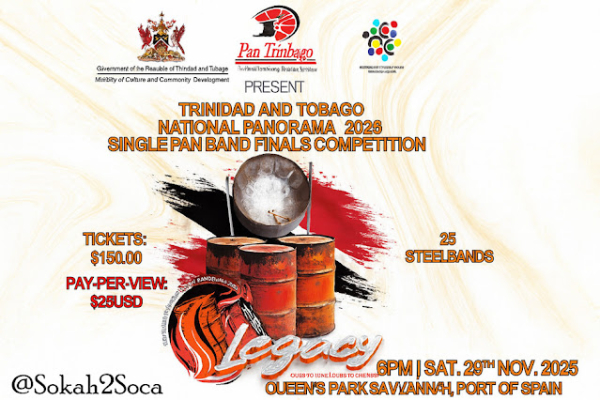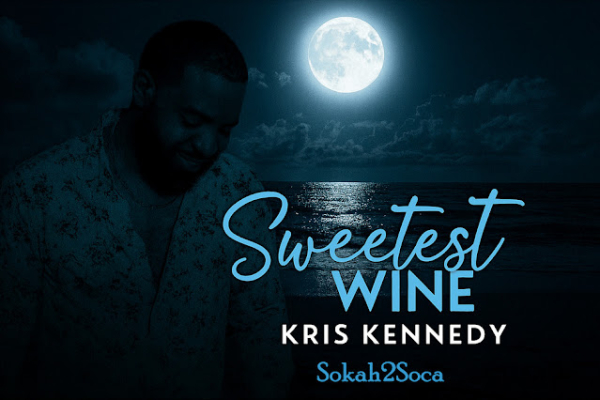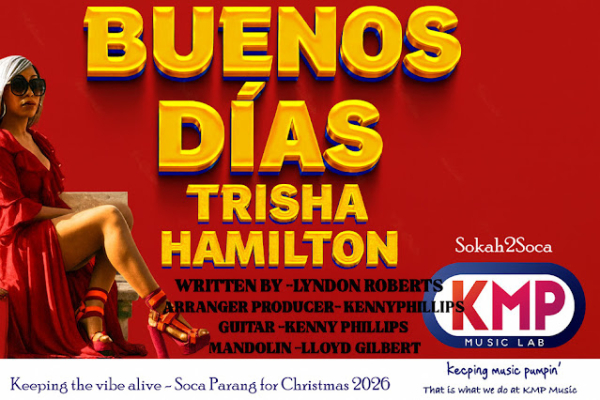Panorama 2026 Single Pan Finals - San Juan East Side Symphony wins Again
By Ananda/Sokah2Soca
in
Blog
December 06, 2025
Dive deeper into Caribbean music and culture at Sokah2Soca — your go-to source for Soca, Calypso, and Carnival coverage. First published on Sokah2Soca, now streaming live via Island Vybe Radio.
Last night in Port of Spain, Trinidad, the Steelband's sound once again captivated the audience. Panorama 2026 kicked off with the finals of the Single Pan bands in late November 2025, and for those on the ground, it felt like late January 2026 with a carnival in the air. The 25 competing bands gave their best performances, the judges judged; and the winner and runners-up were announced. And here we are with the results. Congratulations to San Juan East Side Symphony Steel Orchestra on your victory in the Single Pan Band Category of Panorama 2026! And if you did not know, they are repeat champions after taking the prize for carnival 2025.
Congratulations as well to all participating bands for your passion, preparation, and powerful performances in celebration of our national musical instrument—the steelpan.
It was an unforgettable evening at Queen’s Park Savannah, where the San Juan East Side Symphony Steel Orchestra erupted in celebration after delivering their triumphant rendition of “Jumbie” by Machel Montano, masterfully arranged by Duvone Stewart. Their performance secured the crown at the Pan Trinbago National Panorama 2026 Single Pan Band Finals, adding yet another glorious chapter to their enduring musical legacy.
The energy of Panorama reminds us: radio can capture the sound but not all sound engineers can get it right! Having said that, nothing compares to seeing the steelpan in full glory—the movement, the joy, the artistry.
The results for the top 10 bands are posted below:
- San Juan East Side Symphony - Jumbie - 285 points
- La Creole Pan Groove - Pan By Storm - 284
- Chord Masters Steel Orchestra—Showdown (Band Meet Band)—280
- Metro Stars Steel Orchestra - Kettle Pot - 277
- New Age Trend Setters - Mystery Band - 274 (tie 5th)
- Hope Pan Grove—Like Ah Boss—274 274 (tie 5th)
- Trinidad & Tobago Prisons Service Steel Orchestra - Moving (To the Left)—273
- Trinidad & Tobago Police Service Steel Orchestra - Toro Toro - 273
- Epic Koskeros Steel Orchestra - Toco Band - (tie 9th)
- D'Original Woodbrook Modernaires Steel Orchestra - Ah Cyah Wait - 269 (tie 9th)
The full results can be found on the Pan Trinbago Facebook page at the following link: National Panorama S2026 Single Pan Finals Results.
Addendum: A Call for Sonic Justice
While the energy of Panorama 2026 was undeniable, the audio quality of the performances circulating on YouTube falls heartbreakingly short. These unofficial uploads—often by unknown sources—fail to capture the brilliance, clarity, and emotional depth of the steelpan performances we witnessed.
However, when WACK Visual Radio took the lead, the sound quality was impeccable. The music felt alive. It honored the instrument, the players, and the legacy.
Pan Trinbago must do better. The national instrument deserves official recordings—released on YouTube or made available to cultural storytellers and bloggers—so the world can hear steelpan in its full glory. Anything less is a disservice to the artform and the artists who pour their souls into every note.
Steelpan is not background noise. It’s heritage. It’s heart. It’s ours to love, ours to cherish. We managed to get the WeCapture recordings and replaced the YouTube video with the top performances from the finals.
Let us spread awareness of the culture of the Caribbean diaspora.
We do this to promote Caribbean culture, musicians, and music producers. We are able to honor and promote the rich sounds and stories of the Caribbean thanks to your support. Together, we can ensure that this rich cultural legacy reaches a wider audience and fosters creativity and connections. While it is important to always purchase music, you should avoid sharing promotional music because doing so denies essential revenue to songwriters, producers, and artists. You can find all of our posts online on social media platforms like Facebook, YouTube, Instagram, Spotify, and SoundCloud. We recommend that you explore your favorite content on FeedSpot/RSS Feed, Threads, Bluesky, and Twitter/X, including email subscriptions. Thank you in advance.
Production Notes/Music Credits:
Competition: Single Pan Finals 2026
Venue: Queens Park Savannah
Origin: Trinidad, Republic of Trinidad & Tobago
Genre: Steelband Music ?
?Listen. Share. Amplify. Our artists embody culture not only during Carnival but also on a daily basis. Sokah2Soca—Where Rhythm Lives and Calypso, Steelband Music, and Soca are thriving!
We present the music here for your listening pleasure and promotional purposes only, adhering to the "Fair Use" Musical Content Copyright Disclaimer under Section 107 of the Copyright Act 1976. Sokah2Soca/Soca Music Blog © 1990 by Santiwah is licensed under CC BY-SA 4.0. To view a copy of this license, visit https://creativecommons.org/licenses/by-sa/4.0/.
♫Please click the small triangle button in the music player below to listen now.
The song "Jumbie (Madness Muv Short Edit)" by Machel Montano is at the top, while the arrangement by San Juan East Side Symphony/Duvonne Stewart is at the bottom along with other band performances.
“Ah Passing by Yuh”—Because War Cyah Stop a Trini Lime!
By Ananda/Sokah2Soca
in
Blog
December 06, 2025
This post first appeared on Sokah2Soca, where Caribbean music meets wit, rhythm, and real talk. Island Vybe Radio spins the tunes—we decode the culture.
Back in World War II, when the Americans set up bases in Trinidad, calypsonians had a lyrical field day—rum, romance, and radar stations all made it into the verses. Fast forward to 2025: the Americans are back in the region, Venezuela’s in the mix… and yet, calypso has been quiet. But leave it to Christmas and Parang Soca to break the silence—with a chaser of punch and pepper sauce.
Enter “Ah Passing by Yuh”—a festive Parang Soca release where Yung Bredda kicks things off with, “Wa yuh say Marcia?” and Marcia Miranda fires back, “War? It has no war in TNT, Yung Bredda!” And just like that, we outside!
This tune is pure holiday mischief: drinks flowing, vibes glowing, and not a single verse asking for a ceasefire. The animated video adds extra sparkle, proving once again that in Trinidad, even geopolitical tension gets a rhythm section.
So if you’re wondering how Trinis handle global drama during the holidays, the answer is simple: We party. War or no war. Because as we always say: Anytime is Trinidad time, and Trinidad time is party time.
Let us spread awareness of the culture of the Caribbean diaspora.
We do this to promote Caribbean culture, musicians, and music producers. We are able to honor and promote the rich sounds and stories of the Caribbean thanks to your support. Together, we can ensure that this rich cultural legacy reaches a wider audience and fosters creativity and connections. While it is important to always purchase music, you should avoid sharing promotional music because doing so denies essential revenue to songwriters, producers, and artists. You can find all of our posts online on social media platforms like Facebook, YouTube, Instagram, Spotify, and SoundCloud. We recommend that you explore your favorite content on FeedSpot/RSS Feed, Threads, Bluesky, and Twitter/X, including email subscriptions. Thank you in advance.
Production Notes/Music Credits:
Song Title: Ah Passing by Yuh
Artist/Performed by: Yung Bredda & Marcia Miranda
Produced By Jesse John Of Optimus Productions TT LTD
Mix and Master by WMGLab
Written By Shumba Mahluli.
Origin: Trinidad, Republic of Trinidad & Tobago
Genre: Parang Soca ?
?Listen. Share. Amplify. Our artists embody culture not only during Carnival but also on a daily basis. Sokah2Soca—Where Rhythm Lives and Calypso, Steelband Music, and Soca are thriving!
We present the music here for your listening pleasure and promotional purposes only, adhering to the "Fair Use" Musical Content Copyright Disclaimer under Section 107 of the Copyright Act 1976. Sokah2Soca/Soca Music Blog © 1990 by Santiwah is licensed under CC BY-SA 4.0. To view a copy of this license, visit https://creativecommons.org/licenses/by-sa/4.0/.
♫Please click the small triangle button in the music player below to listen now.
Sweetest Wine by Kris Kennedy: A Groove Soca Correction
By Ananda/Sokah2Soca
in
Blog
December 06, 2025
Dive deeper into Caribbean music and culture at Sokah2Soca — your go-to source for Soca, Calypso, and Carnival coverage. First published on Sokah2Soca, now streaming live via Island Vybe Radio.
On second thoughts, I have to correct my first impression of the Late Night Riddim—and it all happened after listening to Kris Kennedy’s "Sweetest Wine."
Now don’t get me wrong: I’m still not sold on every track in the riddim. I won’t get into what I like or don’t like. This post is about celebrating Kris Kennedy, because Sweetest Wine is the song that shifted my perspective.
If you didn’t catch my first post about the riddim, here’s a quote that summed up how I felt at the time:
“Let’s try and unpack my thoughts. As I said above, the production feels too simple. Therefore, what does that mean? The Late Night Riddim leans into a minimalistic vibe. While some fans appreciate the stripped-down sensuality, others—like myself—might find it lacking the layered complexity or punch that defines more memorable Soca hits.”
But here’s the thing: sometimes, simplicity is all it takes to make a song resonate. A good vibe, lyrics that land, and a voice that connects with the listener. That’s what I found in Sweetest Wine.
It’s Carnival time, and with every feting season, people are looking for that “sweetest wine” on the dance floor. Kris Kennedy taps into that desire with ease. The groove, the tone, the delivery—it all works. I get it now.
If you’re a fan of Groove Soca, like I am, this track deserves a spot on your playlist. The flood of releases is here, but "Sweetest Wine" stands out.
So tell me—what do you think about this song? Did it hit you the way it hit me?
Let us spread awareness of the culture of the Caribbean diaspora.
We do this to promote Caribbean culture, musicians, and music producers. We are able to honor and promote the rich sounds and stories of the Caribbean thanks to your support. Together, we can ensure that this rich cultural legacy reaches a wider audience and fosters creativity and connections. While it is important to always purchase music, you should avoid sharing promotional music because doing so denies essential revenue to songwriters, producers, and artists. You can find all of our posts online on social media platforms like Facebook, YouTube, Instagram, Spotify, and SoundCloud. We recommend that you explore your favorite content on FeedSpot/RSS Feed, Threads, Bluesky, and Twitter/X, including email subscriptions. Thank you in advance.
Song Title: Sweetest Wine
Written by: Nesta “Sekon Sta” Boxill & Kris Kennedy
Album Title: Late Night Riddim
Artists/Performed by: Nessa Preppy, Kris Kennedy, Preedy & Sekon Sta
Produced by: Sekon Sta
Engineered (Mixed & Mastered by: Kingston @Sheppard Pro Studios)
Origin: Trinidad, Republic of Trinidad & Tobago
Genre: Soca ?
?Listen. Share. Amplify. Our artists embody culture not only during Carnival but also on a daily basis. Sokah2Soca—Where Rhythm Lives and Calypso, Steelband Music, and Soca are thriving!
We present the music here for your listening pleasure and promotional purposes only, adhering to the "Fair Use" Musical Content Copyright Disclaimer under Section 107 of the Copyright Act 1976. Sokah2Soca/Soca Music Blog © 1990 by Santiwah is licensed under CC BY-SA 4.0. To view a copy of this license, visit https://creativecommons.org/licenses/by-sa/4.0/.
♫Please click the small triangle button in the music player below to listen now.
This post first appeared on Sokah2Soca, where Caribbean music meets wit, rhythm, and real talk. Island Vybe Radio spins the tunes—we decode the culture.
Those who have not listened to this song are missing out on a lot of mischief that it brings. I couldn't help myself and shook my head; there goes Kenny weaving mischievous magic with this music release. Every Christmas season in Trinidad & Tobago, Soca Parang reminds us that music is more than merriment—it’s storytelling, satire, and cultural memory wrapped in festive rhythms. The current state of affairs in the Caribbean with the arrival of US naval forces makes this song a special Christmas treat. Trisha Hamilton's "Buenos Dias" delivers Calypso magic and is a perfect example of how the tradition continues to evolve. On the surface, it’s a lively parang tune with guitars and mandolin sparkling through the arrangement. But alas, when you listen closely, you’ll hear something deeper: the unmistakable voice of calypso picong, sharp and witty, taking aim at politics and society.
Kenny Phillips of K.M.P. produced and arranged the track with songwriting credits to Lyndon Roberts; the track is musically rich. This track is perfectly suited for the parang season. Kenny's guitar style, characterized by his magical finger licks, anchors the rhythm with a sweet Latin vibe, while Lloyd Gilbert’s mandolin contributes a bright, folkloric touch that instantly transports listeners to parang gatherings. Trisha's vocals effortlessly compliments the instrumentation with confidence and style, bringing smiles to the listeners while delivering the message with teasing lyrical bite provided by Lyndon Peters. It’s festive, yes—but it’s also commentary.
Let's now discuss Mr. Lyndon's skillful use of words and his writing abilities, as this is where the song truly excels. He leans into calypso’s tradition of double entendre and wordplay, weaving in references to Trinidad’s Prime Minister and the country’s delicate position with Venezuela. Rumors suggest this song bears a striking resemblance to Trump's Trinidad, in case you missed it. The clever pun on “Diaz” in the title Buenos Dias is more than a greeting—it’s a sly jab, a wink to listeners who catch the political undertones. This song is the essence of calypso, utilizing humor and wit to express truth, even amidst a festive celebration.
At this point, we hope you get it. The element that makes Buenos Dias resonate is its ability to bridge genres and eras. Parang brings the seasonal joy, but calypso provides the sharp tongue. Kaiso, kaiso, yes, Kaiso. Together, they remind us that music in Trinidad is never just background noise—it’s a living archive of our politics, our humor, and our resilience. The guitars and mandolin may sparkle, but it’s the storytelling that lingers.
In the end, Buenos Dias is more than a Soca Parang release. It’s a cultural statement, proof that even in festive times, calypso’s spirit of picong remains alive. Trisha Hamilton, Kenny Phillips, Lyndon Roberts, and Lloyd Gilbert have given us a song that entertains while it provokes thought—a reminder that parang, like calypso, is both joy and mirror.
Let us spread awareness of the culture of the Caribbean diaspora.
We do this to promote Caribbean culture, musicians, and music producers. We are able to honor and promote the rich sounds and stories of the Caribbean thanks to your support. Together, we can ensure that this rich cultural legacy reaches a wider audience and fosters creativity and connections. While it is important to always purchase music, you should avoid sharing promotional music because doing so denies essential revenue to songwriters, producers, and artists. You can find all of our posts online on social media platforms like Facebook, YouTube, Instagram, Spotify, and SoundCloud. We recommend that you explore your favorite content on FeedSpot/RSS Feed, Threads, Bluesky, and Twitter/X, including email subscriptions. Thank you in advance.
Production Notes/Music Credits:
Song Title: Buenos Dias
Artist/Performed by: Trisha Hamilton
Written by: Lyndon Roberts
Arranged/Produced by: Kenny Phillips
Guitar by: Kenny Phillips
Mandolin by Lloyd Gilbert
Recorded at: K.M.P. Music Lab
Origin: Trinidad, Republic of Trinidad & Tobago
Genre: Soca Parang ?
?Listen. Share. Amplify. Our artists embody culture not only during Carnival but also on a daily basis. Sokah2Soca—Where Rhythm Lives and Calypso, Steelband Music, and Soca are thriving!
We present the music here for your listening pleasure and promotional purposes only, adhering to the "Fair Use" Musical Content Copyright Disclaimer under Section 107 of the Copyright Act 1976. Sokah2Soca/Soca Music Blog © 1990 by Santiwah is licensed under CC BY-SA 4.0. To view a copy of this license, visit https://creativecommons.org/licenses/by-sa/4.0/.
♫Please click the small triangle button in the music player below to listen now.





